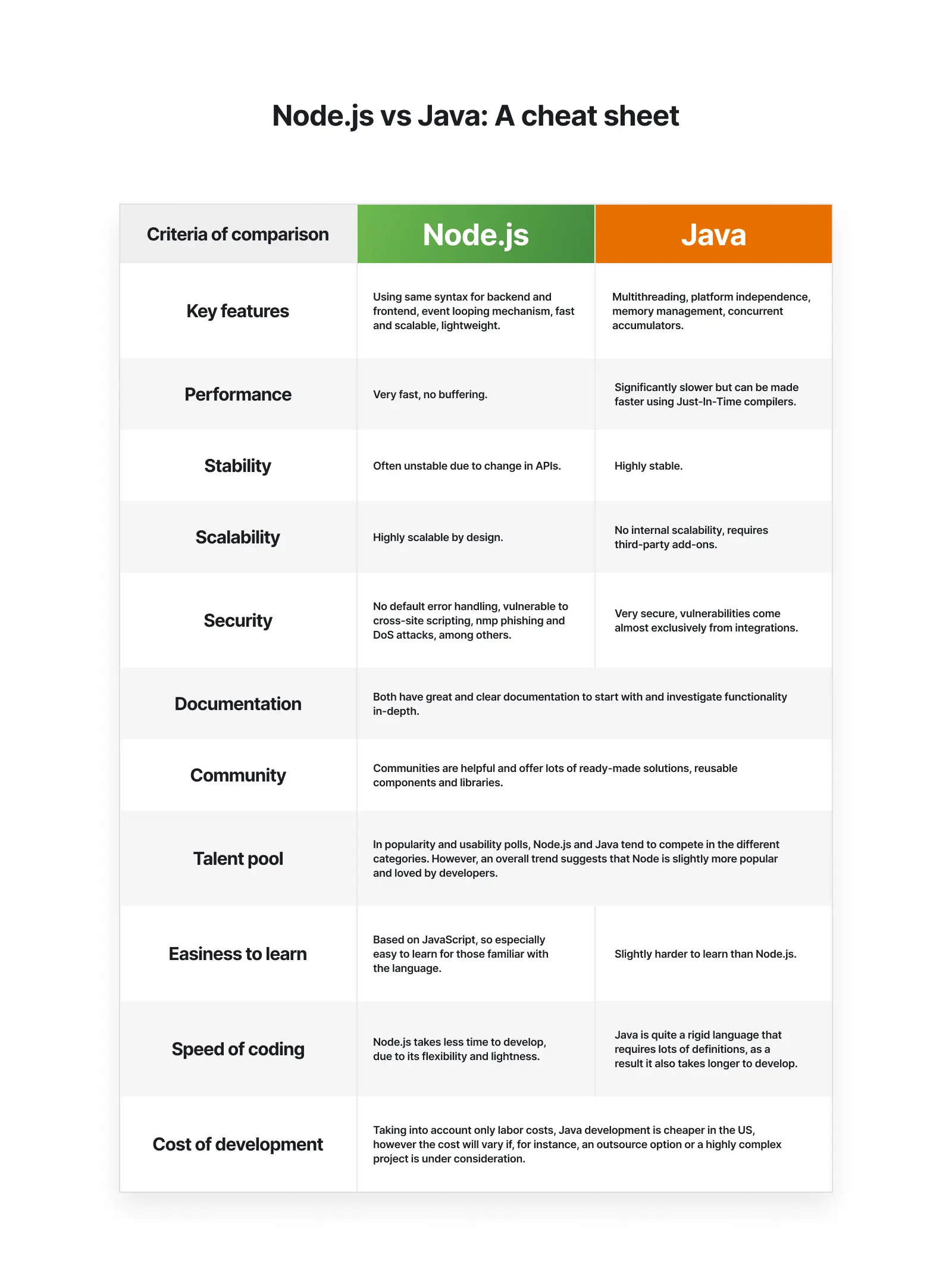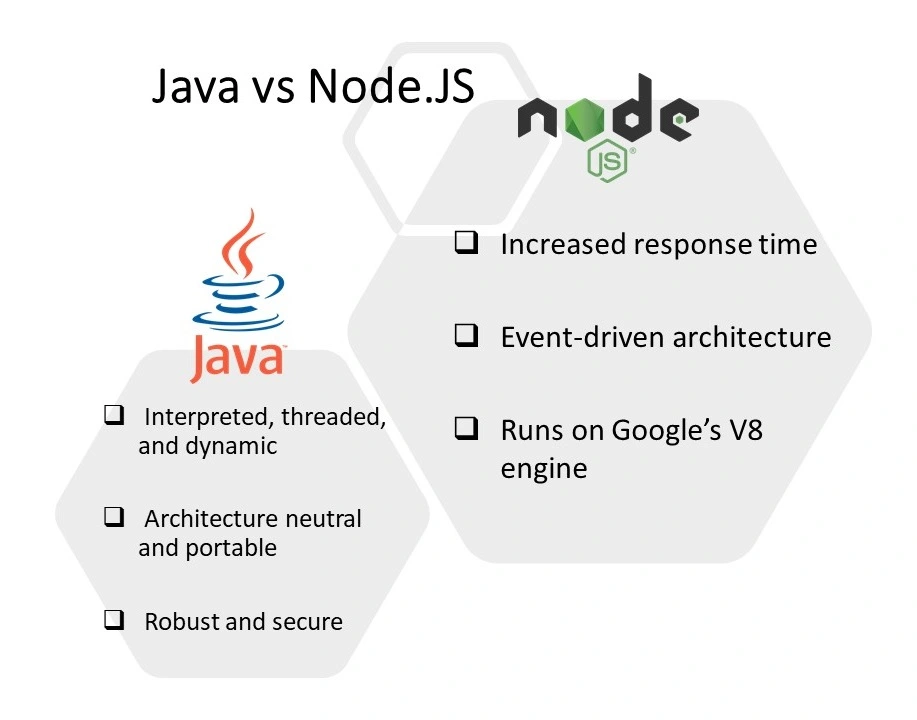In today’s IT world, there is an ongoing battle to decide which is the best programming language. There’s Java, the venerable champion long used by programmers around the world, and Node.js, the relatively new JavaScript runtime environment.
This article compares and contrasts these two powerful tools, focusing on the differences between Node.js and Java. We may never know which is ultimately superior, but we can gain a better understanding of both tools and when to use them.
What Is Node.js?
In 2009, Ryan Dahl developed Node.js. It is a cross-platform, open-source JavaScript (JS) runtime environment that enables programmers to write JavaScript on both the client and server sides. It executes JavaScript applications outside of a browser. Node.js is not a programming language, but rather a JavaScript environment. Node.js also allows developers to execute code on the server side, making it easier to write lightweight, scalable scripts.
Common Applications of Node.js
Many noteworthy companies and organizations use Node.js for their applications.
1. Social Networking
The event loops in Node.js enable apps to receive new data without constantly refreshing, making it ideal for social networking apps. LinkedIn certainly believes so, which is why it switched from Ruby on Rails to Node.js.
2. Data Collection, Analysis, and Visualization
Node.js is ideal for real-time data collection, analysis, and visualization. That data handling capability is used by Heap and YCharts to make their apps faster and more responsive to users.
3. Streaming
Netflix improved the performance of its app by switching to Node.js and utilizing its Stream API. The interface makes it simple to download new components on demand. It sends portions of the app’s code to local machines without disconnecting, caching, or storing temporary data.
4. E-commerce
Groupon switched to Node.js because it required faster speeds and the ability to handle high traffic. PayPal was experiencing performance issues and was one of the first major corporations to experiment with Node.js. In both cases, Node.js solved the problems, resulting in faster page loading times, greater traffic volume handling, and improved overall site performance.
5. Online Marketplaces and Stores
eBay chose Node.js because of its ability to maintain live connections with its servers while handling multiple requests at the same time. When Wal-Mart used Node.js to redesign its mobile app to add more client-side features, it saw similar results.
What Is Java?
Java, created in 1991 by Sun Microsystems’ James Gosling and the “Green Team,” is an object-oriented, class-based, general-purpose programming language. Java’s main characteristics include stability, efficiency, and cross-platform capabilities. Java is one of the most widely used programming languages in the world.
Java is used by programmers to create high-quality, efficient applications for computers and mobile phones. Java is most commonly associated with Android phones, enterprise computing, and several embedded worlds such as Blu-ray disks.
The Java compiler converts the source code of Java to bytecode. This bytecode can then be executed on any operating system that contains a compatible JRE (Java Runtime Environment). That means that any Java source code can be run on any platform, which is one of Java’s most significant advantages.
Common Applications of Java
Java’s age and ubiquity make it easy to find in any industry or institution. Here are a few examples of well-known Java applications:
1. Apps for Android
The vast majority of Android apps are written in Java, frequently in conjunction with Google’s API. Spotify, for example, makes use of Java.
2. Financial Services and E-commerce
Java-based applications are used by Barclays, Citigroup, Goldman Sachs, and other financial institutions, particularly for server-side applications that do not require a front end. Server-side applications receive data from a server, process it, and then pass it on to other processes. Java is also used by Amazon.
3. Industries of Service
Java-based apps are used by Uber and AirBnB.
4. Trading by third parties
Murex, a company that provides financial technology solutions, relies on Java for its trading applications.
5. Big Data
Java is used extensively in big data technologies such as Hadoop, including ElasticSearch, Apache’s HBase, and the open-source Accumulo.
6. Social Media
Java-based apps are used by different social media platforms like Pinterest, LinkedIn, Slack, and Instagram.
7. Search Engines
Google employs Java for server coding as well as the development of user interfaces and Google Docs applications.
You can also find Java on the Internet of Things, scientific applications, and Gmail.
Which One is a Better Option-NodeJS or Java?

- Java is an excellent choice for creating complex web-based, highly concurrent applications, whereas Node JS is ideal for creating small projects.
- Java requires the Java Development Kit, which includes a Java compiler and runtime environment, to be installed on any machine, whereas Node JS requires an installable archive file.
- Java source code is compiled into bytecode, and then bytecode is converted to machine code, ready to run on any platform, whereas Node JS source code is JavaScript, and the Node JS interpreter is used to interpret and execute JavaScript code.
- Java is a server-side language that has nothing to do with the browser, whereas Node JS can be used efficiently on both the client and server sides.
- Node JS is best suited for real-time collaborative drawing or editing applications like Google Docs, whereas Java is heavily used for building complex web-based applications with an already provided framework built in Java.
- Java is an Object-Oriented programming language that must be compiled and run within the JRE (Java Runtime Environment), whereas Node JS is a cross-platform runtime system and environment for JavaScript applications.
- Java easily employs the concept of multithreading, whereas Node JS does not employ the concept of multithreading.
- Java is highly recommended for large-scale projects involving concurrency, whereas Node JS does not handle threads and Java, which is the framework’s weakest point.
- CPU-intensive tasks necessitate massive computational power, which Java can handle, whereas I/O-bound operations such as real-time chat, media streaming, and so on, can be handled well by Node JS.
- Java is a de-facto enterprise standard; it is the most popular programming language in the world, whereas Node JS is a framework based on JavaScript that can achieve parallelism efficiently, as opposed to concurrency.

Finally, it is determined by the applications that will be developed. Anything that can be done with Node JS can also be done efficiently with Java libraries and frameworks. Concurrency in Java allows for the creation of extremely fast applications, whereas the Node JS framework allows for the efficient creation of event-driven I/O bound applications. Finally, it is dependent on the requirement and the developer’s ability to understand the technology.
Spread the love